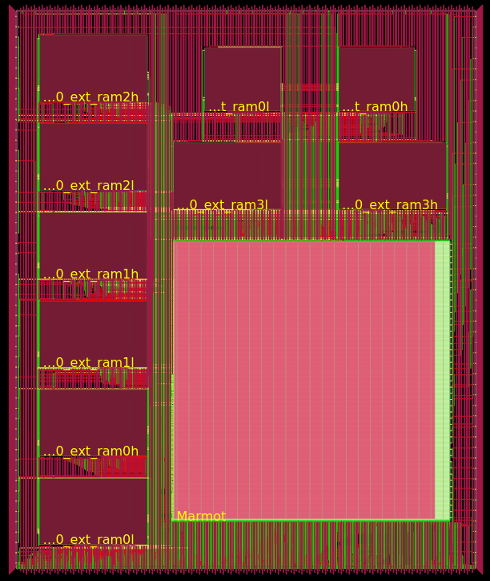Tomorrow at EdgeTech+ 2024, we will be demonstrating our unique RISC-V chip and VGA controller digitally designed by Chisel.
1. JASA Corner at EdgeTech+ 2024, Yokohama Pacifico, November 20-22, 2024
We will exhibit the Marmot Demo and Chisel Demo at the JASA Corner in the EdgeTech+ 2024 venue, which will be held at Yokohama Pacifico on November 20-22, 2024.
The JASA Corner at EdgeTech+ 2024 is located in the exhibition hall of Pacifico Yokohama. The JASA Pavilion is located at booth number CR-11, and introduces JASA’s activities and exhibits member companies. For detailed layout within the Themes venue, please check the official website or venue guide map.

2. “Marmot (RISC-V chip) demo”
We designed a demo using the Marmot chip as an application example of an embedded system. Real-time temperature measurement by a sensor is displayed on a VGA display. We use a proprietary RISC-V chip (commonly known as Marmot, 130nm Skywater process, 25MHz clock operation) designed and prototyped by SH Consulting Co., Ltd. using Google/eFabless free shuttle. The current temperature data obtained from the temperature sensor is displayed on the display with an icon as “current temperature”. The display used is connected to the Marmot board and can display numerical values in real time. We demonstrated the underlying technology of an application that processes real-world data in hardware and displays it instantly.
3. Chisel (VGA controller) demo
We used Chisel to create a digital design, and then designed a VGA controller using the VGA and FPGA boards we created, and then designed a display to create a graphical demo. A simple animation of a UFO-like object moving on the screen is displayed. A UFO-like object is displayed, and a colorful pattern is generated in the background.
Functions
(1) Background switching: You can switch backgrounds by pressing a button.
(2) Dynamic objects: The objects are programmed to move smoothly on the screen.
The display and movement of the objects are implemented on the FPGA using Chisel. The animation runs.
4. Objectives and highlights of the demo exhibition
When you visit, please pay attention to the movement of the sensor data processing and the FPGA graphics processing.
Through the above demos, we aim to make the application of embedded system technology more familiar to you.
(1) Show the possibilities of RISC-V-based design and FPGA design using Chisel.
(2) Introducing the flexibility of digital circuit design and examples of graphic processing applications.
The purpose of this demo is to convey to participants the possibilities of edge computing, embedded systems, and applications that utilize FPGAs.
Marmot Demo: Introduces the basics of practical embedded system design.
Chisel Demo: Provides examples that allow participants to experience the flexibility of hardware design and the implementation of graphic processing.
Requests regarding installation and demonstration.
5. Introduction of our proprietary RISC-V chip
 eFablessから帰ってきたMarmot チップ
eFablessから帰ってきたMarmot チップ

MARMOT チッププロット図

